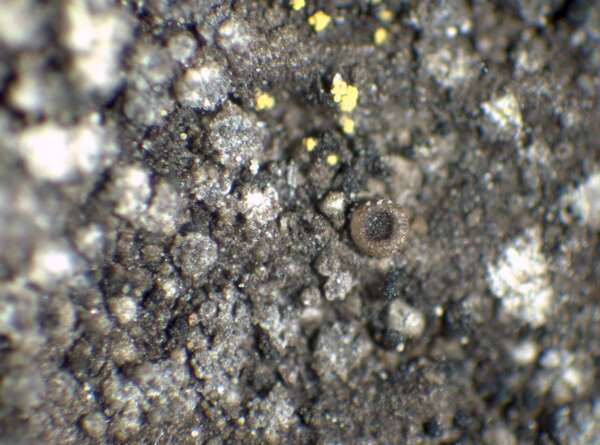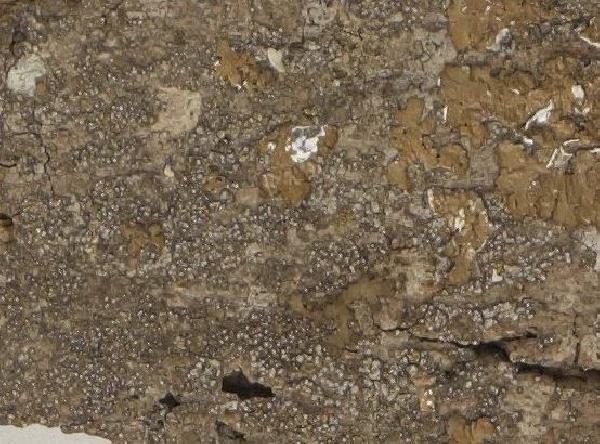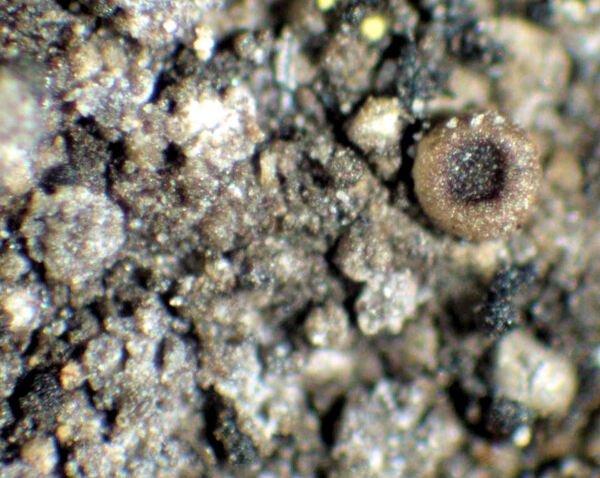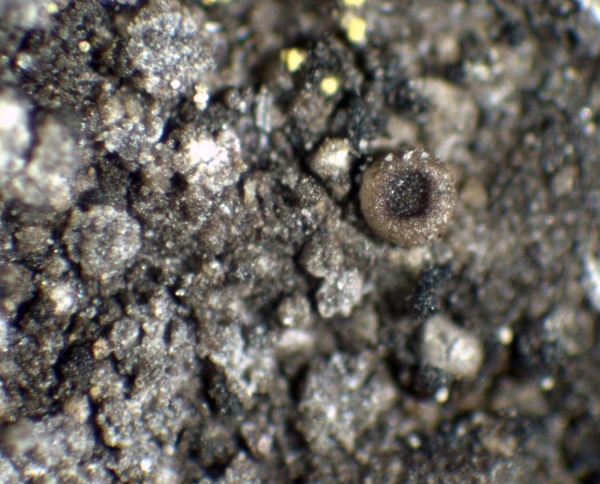Rinodina griseosoralifera Coppins
Lichenologist, 21: 169, 1989.
Synonyms:
Description: Thallus crustose, episubstratic, forming up to 10 cm wide parches, areolate, sorediate, often delimited by a brown prothallus, the areoles dull greenish white, pale grey or greyish brown, 0.1-0.6 mm wide, rounded, flat to slightly convex, usually becoming entirely dissolved into soredia. Soralia numerous, blue-grey, erupting from the upper surface of the areoles, more or less convex, up to 0.2 mm in diam., discrete or a few confluent. Soredia farinose, 12-25(-30) μm in diam., the outer ones blue-grey, K+ brown Apothecia rare, lecanorine, 0.3-0.4 mm across, sessile, with a more or less poriform, brown disc, and a raised, white-grey thalline margin; proper margin brown, forming a narrow ring around the disc. Thalline exciple 70-80 µm wide laterally, expanding in lower part, the cortex ca. 10 µm thick, densely inspersed with crystals, the medulla without crystals; proper exciple brownish in uppermost part, otherwise colourless, c. 15 µm wide laterally, expanding to ca. 30 µm in upper part; epithecium brown, K-; hymenium colourless, up to 125 μm high, the hymenial gel K/I+ blue; paraphyses simple to sparingly branched in upper part, 1.5-2(-3) μm thick at mid-level, the apical cells 3.5-4.5 μm wide; hpothecium colourless, up to 40 μm high. Asci 8-spored, clavate, the K/I+ blue tholus penetrated by a faintly amyloid apical cushion with parallel or diverging flanks, the wall K/I-, surrounded by a K/I+ blue outer layer, Lecanora-type. Ascospores 1-septate, brown, ellipsoid, 18-25(-34) x 10-12(-15) μm, Pachysporaria-type, with a narrow torus, the walls not ornamented. Photobiont chlorococcoid. Spot tests: thallus K+ (sometimes faintly) yellow, C-, KC-, P- or P+ faintly yellow, UV-. Chemistry: atranorin, zeorin, traces of an unidentified terpenoid.
Growth form: Crustose
Substrata: bark
Photobiont: green algae other than Trentepohlia
Reproductive strategy: mainly asexual, by soredia, or soredia-like structures (e.g. blastidia)
Commonnes-rarity: (info)
Alpine belt: absent
Subalpine belt: absent
Montane belt: extremely rare
Dry submediterranean belt: very rare
Humid submediterranean belt: very rare
Padanian area: absent
pH of the substrata:
1 2 3 4 5
Solar irradiation:
1 2 3 4 5
Aridity:
1 2 3 4 5
Eutrophication:
1 2 3 4 5
Poleotolerance:
0 1 2 3
Altitudinal distribution:
1 2 3 4 5 6
Rarity
absent
extremely rare
very rare
rare
rather rare
rather common
common
very common
extremely common
Loading data...
Occurrence data
Predictive map

P.L. Nimis; Owner: Department of Life Sciences, University of Trieste
Herbarium: TSB (25277)
2002/05/13

Modified from: https://gzu.jacq.org/GZU000299617
GZU000299617 - Collector Coppins,B.J. 4672
Date 1980-03-13
Location United Kingdom
Label Dunbarton, Loch Lomond: Ross Priory ; Alt. 15 m
Habitat on trunk of Acer pseudoplatanus in avenue
Habitus
Annotations 26/41.87
[A. Scharfetter (GZU) 2013-03-05: Label shows additionally handwritten annotation (by B. Coppins?) "Isotypus", also J. Poelt annoted "Isotypus" directly on card with mounted specimen, but according to protolog it is a paratype.]
Growth form: Crustose
Substrata: bark
Photobiont: green algae other than Trentepohlia
Reproductive strategy: mainly asexual, by soredia, or soredia-like structures (e.g. blastidia)
Commonnes-rarity: (info)
Alpine belt: absent
Subalpine belt: absent
Montane belt: extremely rare
Dry submediterranean belt: very rare
Humid submediterranean belt: very rare
Padanian area: absent
pH of the substrata:
| 1 | 2 | 3 | 4 | 5 |
Solar irradiation:
| 1 | 2 | 3 | 4 | 5 |
Aridity:
| 1 | 2 | 3 | 4 | 5 |
Eutrophication:
| 1 | 2 | 3 | 4 | 5 |
Poleotolerance:
| 0 | 1 | 2 | 3 |
Altitudinal distribution:
| 1 | 2 | 3 | 4 | 5 | 6 |
Rarity
absent
extremely rare
very rare
rare
rather rare
rather common
common
very common
extremely common
Loading data...
Occurrence data
Predictive map

P.L. Nimis; Owner: Department of Life Sciences, University of Trieste
Herbarium: TSB (25277)
2002/05/13









